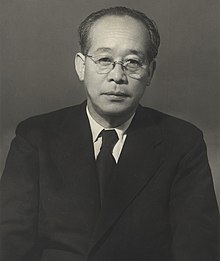Kenji Mizoguchi | |
|---|---|
 | |
| Born | 16 May 1898 |
| Died | 24 August 1956 (aged 58) Kyoto, Japan |
| Nationality | Japanese |
| Occupation(s) | Film director, screenwriter |
| Years active | 1923–1956 |
| Notable work |
|

Kenji Mizoguchi (溝口 健二, Mizoguchi Kenji, 16 May 1898 – 24 August 1956) was a Japanese filmmaker who directed roughly one hundred films during his career between 1923 and 1956.[1][2][3] His most acclaimed works include The Story of the Last Chrysanthemums (1939), The Life of Oharu (1952), Ugetsu (1953), and Sansho the Bailiff (1954),[4][5] with the latter three all being awarded at the Venice International Film Festival. A recurring theme of his films was the oppression of women in historical and contemporary Japan.[2][3][6] Together with Akira Kurosawa and Yasujirō Ozu, Mizoguchi is seen as a representative of the "golden age" of Japanese cinema.[7]
- ^ "溝口健二". Japanese Movie Database (in Japanese). Retrieved 6 October 2022.
- ^ a b "溝口健二". Kinenote (in Japanese). Retrieved 6 October 2022.
- ^ a b "溝口健二". Kotobank (in Japanese). Retrieved 6 October 2022.
- ^ "The Tales and Tragedies of Kenji Mizoguchi". Harvard Film Archive. 2014. Retrieved 6 October 2022.
- ^ Jacoby, Alexander (October 2002). "Mizoguchi, Kenji". Senses of Cinema. Retrieved 6 October 2022.
- ^ Jacoby, Alexander (2008). Critical Handbook of Japanese Film Directors: From the Silent Era to the Present Day. Berkeley: Stone Bridge Press. ISBN 978-1-933330-53-2.
- ^ Sharp, Jasper (15 May 2015). "Kenji Mizoguchi: 10 essential films". British Film Institute. Retrieved 6 October 2022.